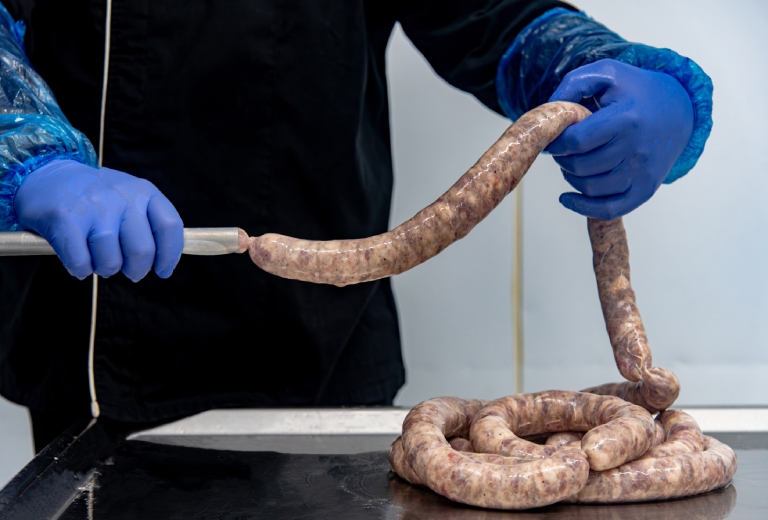Crete, the largest of the Greek islands, is renowned for its rich cultural heritage, stunning landscapes, and vibrant culinary traditions. Among the island’s many gastronomic delights, traditional Cretan sausage holds a special place. Known for their unique flavors and artisanal methods of preparation, Cretan sausages are a testament to the island’s enduring food culture. This text explores the history, ingredients, techniques, and cultural significance of traditional Cretan sausage making, inviting you to discover the art and flavors behind this beloved delicacy.
The Historical Roots of Cretan Sausage Making
The tradition of sausage making in Crete dates back centuries, reflecting the island’s agricultural abundance and the ingenuity of its people in preserving meat. The practice has been passed down through generations, evolving but retaining its core principles and techniques.
1. Ancient Origins: The concept of preserving meat through curing and drying is ancient. The Minoans, one of Europe’s earliest advanced civilizations, were known for their sophisticated agricultural practices and culinary innovations. Sausage making likely developed as a method to preserve meat, ensuring a reliable food supply throughout the year.
2. Venetian and Ottoman Influences: During the Venetian (1204-1669) and Ottoman (1669-1898) periods, Cretan cuisine was influenced by various culinary traditions. Sausage making incorporated spices and techniques from these cultures, enriching the flavors and methods used in Crete.
Ingredients and Techniques
Traditional Cretan sausages are characterized by their simplicity, high-quality ingredients, and distinctive flavors. The ingredients and techniques used in making these sausages reflect the island’s agricultural bounty and culinary heritage.
1. Key Ingredients:
- Pork: The primary ingredient in Cretan sausages is pork, often sourced from local, free-range pigs. The quality of the meat is crucial, as it forms the foundation of the sausage’s flavor.
- Fat: A good balance of meat and fat is essential for the texture and taste of the sausage. Pork fat is typically used, adding richness and juiciness.
- Spices and Herbs: Traditional Cretan sausages are seasoned with a blend of spices and herbs, including garlic, black pepper, cumin, coriander, and oregano. The use of local herbs imparts a unique, aromatic quality.
- Red Wine: Many Cretan sausages are marinated in red wine, which enhances the flavor and acts as a natural preservative.
- Salt: Salt is a crucial ingredient for curing the meat and enhancing its natural flavors.
2. The Sausage Making Process:
- Meat Preparation: The pork is finely chopped or coarsely ground, depending on the desired texture. The meat and fat are mixed together to achieve the right consistency.
- Seasoning: The meat mixture is seasoned with spices, herbs, garlic, and red wine. The ingredients are thoroughly mixed to ensure even distribution of flavors.
- Stuffing: The seasoned meat is stuffed into natural casings, typically made from pork intestines. This is done by hand or with the aid of a sausage stuffer.
- Drying and Curing: Once stuffed, the sausages are hung in a cool, dry place to cure. This process can take several days to weeks, depending on the size of the sausages and the desired flavor. During this time, the flavors meld and the sausages develop their distinctive taste and texture.
Cultural Significance and Modern Adaptations
Traditional Cretan sausage making is more than just a culinary practice; it is a cultural heritage that reflects the island’s history, community, and way of life.
1. Community and Family Traditions: Sausage making is often a communal activity, bringing together families and communities. It is typically done during the winter months, following the annual pig slaughter. This event, known as “hoirosfagia,” is a time for celebration and togetherness, where families gather to prepare and preserve meat for the coming year.
2. Celebratory Foods: Cretan sausages are a staple at various celebrations and festive occasions. They are enjoyed at family gatherings, religious holidays, and village festivals, symbolizing hospitality and the sharing of abundance.
3. Modern Adaptations: While traditional methods remain popular, modern adaptations of Cretan sausage making have also emerged. Artisanal producers and home cooks experiment with new flavors and techniques, incorporating ingredients such as fennel, orange zest, and various peppers. These innovations reflect the dynamic nature of Cretan cuisine, balancing tradition with creativity.
Enjoying Cretan Sausages
Cretan sausages are incredibly versatile and can be enjoyed in various ways, both as a main dish and as an ingredient in other recipes.
1. Grilled or Fried: One of the simplest and most popular ways to enjoy Cretan sausages is to grill or fry them. This method enhances their smoky, aromatic flavors, making them a perfect accompaniment to bread, cheese, and olives.
2. Stews and Casseroles: Cretan sausages are often used in traditional stews and casseroles, adding depth and richness to the dish. They pair well with beans, lentils, and vegetables, creating hearty and satisfying meals.
3. Meze Platters: Sliced Cretan sausages are a common component of meze platters, which are assortments of small dishes served as appetizers or snacks. They are often accompanied by dips, cheeses, pickles, and other cured meats, providing a delightful array of flavors and textures.
4. Contemporary Cuisine: In modern Cretan cuisine, sausages are used creatively in various dishes, from pasta and risotto to pizzas and sandwiches. Chefs and home cooks alike embrace the versatility of this traditional ingredient, incorporating it into contemporary culinary creations.
Conclusion
Traditional Cretan sausage making is a cherished culinary art that reflects the island’s rich history, cultural heritage, and community spirit. The simple yet flavorful ingredients, combined with time-honored techniques, result in sausages that are not only delicious but also deeply rooted in Cretan identity. By preserving and celebrating this tradition, the people of Crete continue to honor their past while embracing the culinary innovations of the present. Discovering the world of Cretan sausages offers a unique and flavorful insight into the island’s vibrant gastronomy and enduring cultural traditions. Whether enjoyed in a rustic village taverna or as part of a festive family meal, Cretan sausages provide a taste of Crete’s authentic and timeless culinary heritage.


